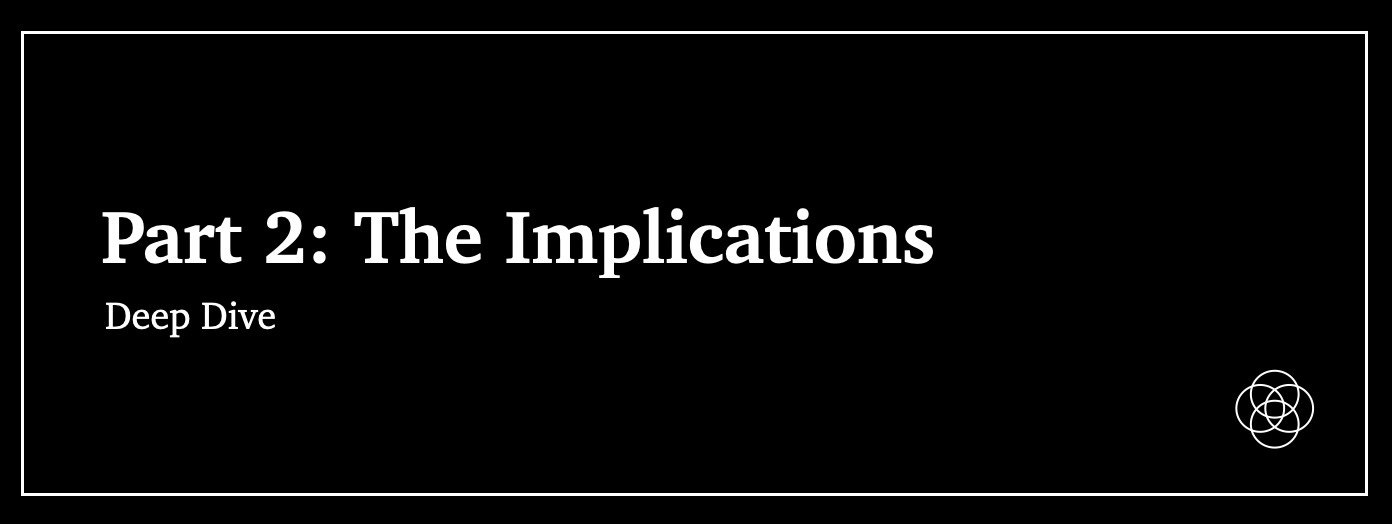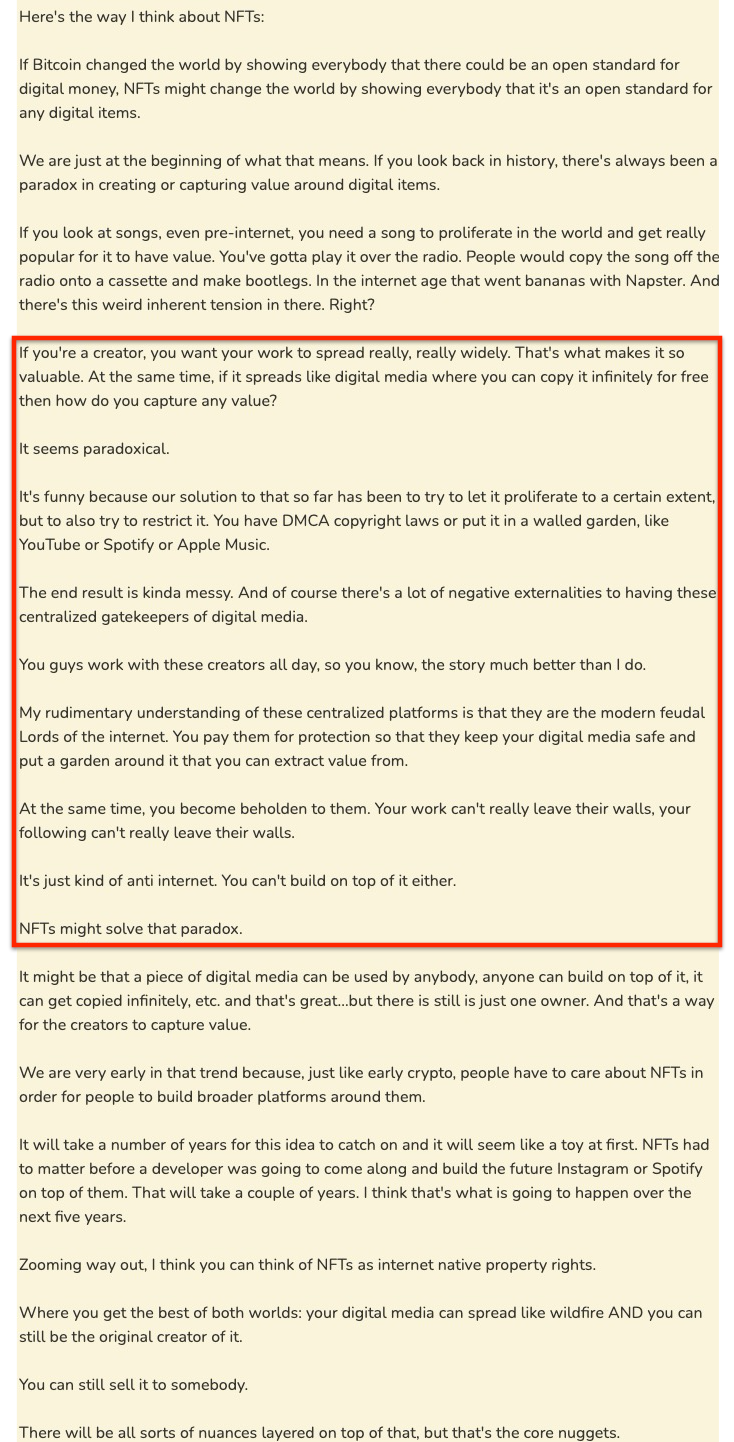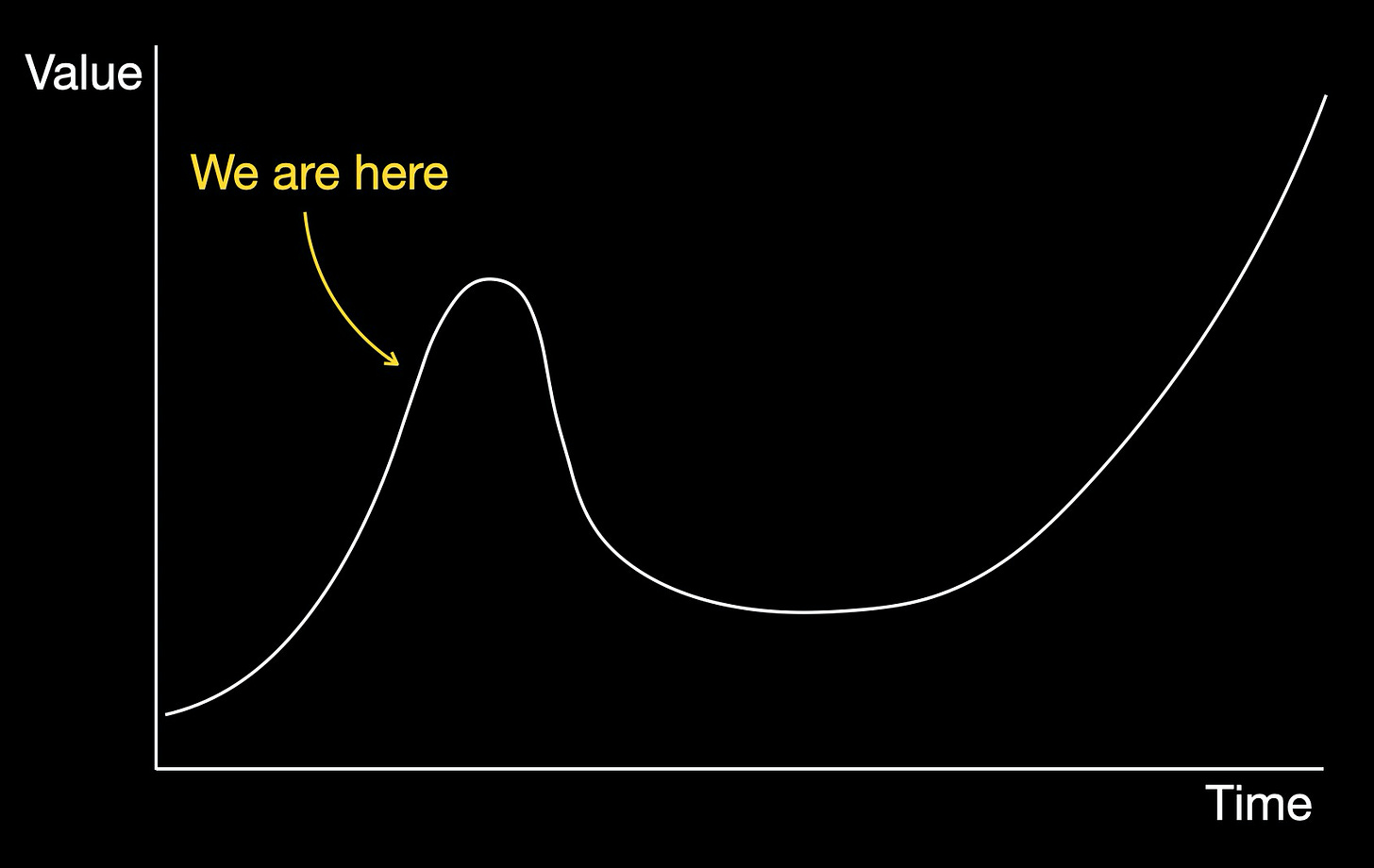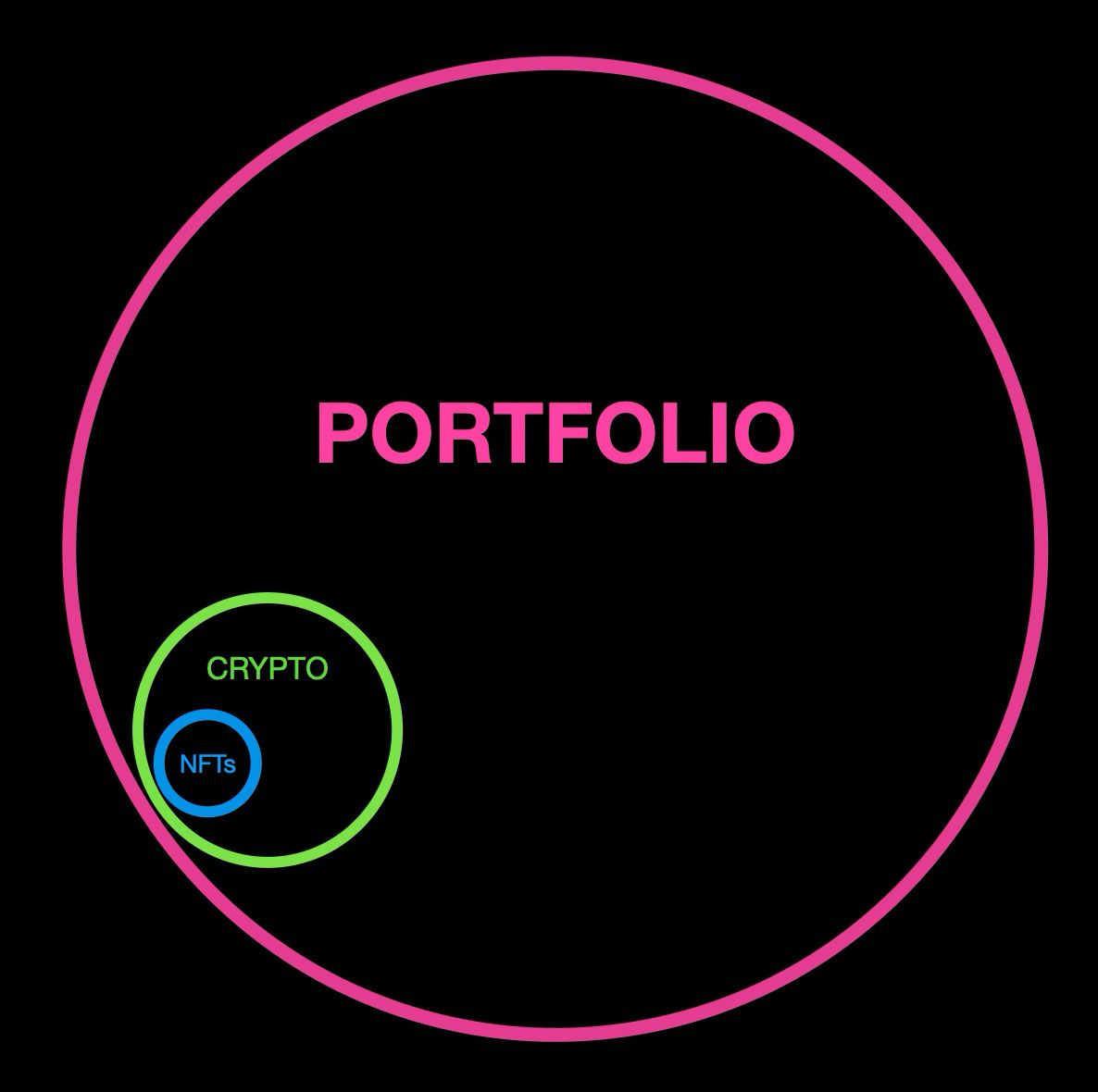Hi y’all,
I’ve been hearing about NFTs (Non-Fungible Tokens) more and more the past few months. You probably have too. For me, it was in the context of sports, art or music.
Sports. I have zero interest in owning Steph Curry’s latest 3-point shot.
Art. I’m not a collector of art, nor can I claim to have a deep appreciation for it.
Music. I enjoy music but not a hardcore fan, and I am not a musician myself.
So, NFTs didn’t pique my interest much. And thus, I never took the time to dig into any potential deeper applications.
Non-fungible tokens (NFTs) are unique, digital items with blockchain-managed ownership. Examples include collectibles, game items, digital art, event tickets, domain names, and even ownership records for physical assets.
Last week, the NFT-hype officially hit the mainstream.
Beeple (yes, that’s what the dude calls himself) sold an NFT for $69M USD. Important to note: he made a piece of art every day for 13 years (each took 2-3 hours), and last week’s NFT was all of those pieces of art in one single NFT. So, for what it’s worth, he is no “overnight success.” Here is Beeple’s piece, Everydays: The First 5,000 Days:
Then, two different “CryptoPunks” sold for $7.5M USD, each. The most expensive one was sold by Dylan Field, CEO & Co-founder of Figma.
All of these pieces sold to pseudonymous buyers, which is very common in the NFT space.
Grimes sold $6M USD worth of NFTs. Jack Dorsey sold his first tweet as an NFT for $2.9M USD. And Elon, obviously (the meme-lord that he is), got in on the action this past week—so far denying an offer of $1.1M USD.
The new all-time-high price of Bitcoin also added to the groundswell of the NFT-mania last week.
I had seen all these headlines, and yet I still wasn’t convinced there was anything worth spending time to better understand.
Then, last Friday night, Aarthi and Sriram had yet another historic line-up of guests on The Good Time Show on Clubhouse. And things finally clicked for me. All at once. Let me explain.
Serendipity, spontaneity, and otherwise impossible dynamics created delightful excitement, entertainment and seemingly exclusive knowledge.
The entire Clubhouse was magic—exactly what makes a great Clubhouse Room, great.
Act 1
Here are the five minutes that instantly changed my view of NFTs.
Dylan Field gave a speech on why he sold 7804. It was scripted, which is not very common on Clubhouse. Fairly cheesy and felt somewhat forced. But, at the risk of sounding silly, it was incredibly moving and powerful. Here are the opening lines:
For those who don't know, CryptoPunks was the first Ethereum crypto art project.
It was created in 2017 by two visionary artists, Matt Hall and John Watkinson. There are only 10,000 CryptoPunks, which anyone could claim for free in the early days. And of those 10,000 CryptoPunks, there are only 88 Zombie Punks, 24 Apes, 9 Aliens and exactly one Alien Punk smoking a pipe. Its name is 7804. And I personally believe that in 100 years, we will look back on 7804 as the Mona Lisa of digital art.
I published the entire transcript of Dylan’s speech here: Farewell, 7804 | The Mona Lisa of Digital Art.
Act 2
Pugglia, the buyer(s) of CyptoPunk 7804, tweeted at Sriram during the Clubhouse, saying he was in the (Clubhouse) Room. He didn’t end up coming on Stage, but it was wild to have these interactions in real time. More thoughts from Pugglia later in this post.
Act 3
MetaKovan and Twobadour are the two anons who bought the Beeple piece for $69M. They were also on the Stage, and chimed in with some fascinating information—among other things, they have been anonymous and away from their family for seven years, to work on crypto—that’s what I like to call a “full send.”
Act 4
Balaji also joined for a few minutes. His insight also blew my mind. Here is the part he mentioned that further deepened my conviction around NFTs:
If everyone thinks about how much time they’re spending looking at a screen of some kind, whether mobile or a laptop… for many people, it’s more than 50% of their waking hours. Which means that probably, most of the rest of your life will be spent in “the matrix.” That includes VR, podcasts, essentially any time interacting with the internet, in the broadest sense.
And so, if that’s the case, more of our perceived world is digital. And beautifying that world with digital art will be a big thing. We already see that in video games, where people will spend hours working for some sword. So, part of the thesis is: much more of life is going digital, so art will go digital as well as the entire economy eventually becomes a crypto-economy.
This makes intuitive sense to me. And in my mind, the inevitable future is: digital things bought, with digitally-native money, to use in the digital world. Whether that’s art, music, tickets, avatars, or otherwise.
Act 5
Justin (aka 3LAU), a fairly successful musician, was another guest on the show.
He talked about how he started playing around with NFTs in 2017, saying that he was most excited to interact with fans directly, without having to go through a centralized platform (aka toll collectors like: Apple, Youtube, Spotify). Earlier this month, he tokenized his album + audio/visual art, and attracted over $11.7M USD worth of bids on NiftyGateway.
This idea that my music has been streamed over a billion times, and I don’t know who these people are, has always bothered me.
I guess, being an early believer, really does pay off.
Closing thoughts
The whole Clubhouse Show felt raw and authentic. I felt like I was a fly on the wall, in some basement, with a bunch of nerds who have somehow stumbled into the limelight, after decades of being made fun of, for spending their Saturday nights hacking video games together, instead of being at their high school basketball game (sorry for any of you who may be reading this! I am genuinely jealous of you! 😀)
The fact that someone, who we don’t know their real name or identity, paid $7.5M USD for a pixelated piece of art—well, it moved me. So much so, that I woke up the next day, actually considering spending a stupid amount of money to buy a CryptoPunk of my own (don’t worry @mom and @dad, I didn’t, and won’t… any time soon… anyway).
I pitched the idea of buying a CryptoPunk to my wife the next morning. I told her we could use our Bitcoin for a CryptoPunk. You can listen to our 8-minute conversation below 🙃 And if you do listen, let me know if you like these little embedded “micro-podcasts” and I’ll do more of them.
Why NFTs are revolutionary
Are NFTs overhyped right now?
How can one participate as an investor?
How can one participate as an artist?
Future Prediction
1. Why NFTs are revolutionary
First, to re-iterate: non-fungible means non-replaceable for the same. Meaning, a one-of-a-kind piece of art only exists once. I would care *which* one is hanging on my wall. A dollar bill, or Bitcoin, on the other hand, is fungible. Meaning, I don’t care *which* bill/coin I have in my wallet. Because they’re interchangeable.
Why does this matter more today than it did twenty years ago?
Technology has gotten really good at duplicating things and making them appear identical to the original (see: deepfakes).
NFTs solve this problem by putting a hash on a blockchain that verifies “this is the legitimate, verified, original.”
This is revolutionary.
This was the second phase of my journey with NFTs last week. The first phase was being moved during the Clubhouse conversation, particularly around CryptoPunks. The second phase was in the deep-dive that followed the next day. This was where I had a bunch of smaller lightbulb moments about how NFTs are much bigger than just owning a silly piece of pixelated art. In fact, it is likely going to be much bigger than just art.
Remember, if an NFT solves a problem by putting a hash on a blockchain, which verifies “this is the actual original,” think of all of the use cases. Car or home titles, tickets to events, nearly unlimited use-cases in law, citations in academia, video game items, and of course, DeFi (decentralized finance).
What else was part of my unintentional “NFT deep-dive?”
- Opened 139 tabs
- Consumed 25+ hours of NFT videos, podcasts and Clubhouse Rooms
- Joined 16 NFT Discord Servers
- Chatted with 40+ certified CryptoPunk owners (yes, I was fanboying)
- Set up a MetaMask wallet and used Ethereum on UniSwap
- Got scammed once (luckily, didn’t end up losing any money)
Below are a few of the best resources and key takeaways.
This podcast episode by Kevin Rose was super informative: NFTs: Blockchain-Powered Art, Trading Cards, Music, and More with Aftab Hossain.
And check out this YouTube video with Coinbase Co-Founder on the Future of NFTs and Bitcoin: Fred Ehrsam - Creator Economics #17. Here is the best part of the episode, pulled it from the script:
And finally, if you want to read more about the “bull case” for CryptoPunks as the “first NFT ever,” check out this post: The Fat CryptoPunks Thesis.
What is novel about CryptoPunks is they are the first pieces of digital art on Ethereum that have a built in means of verifying unique ownership. This is done through cryptographic hashing such that a wallet address on Ethereum can have ownership rights over a CryptoPunk in a secure manner. As people have caught on to this, there has been a surge of interest in buying punks.
2. Are NFTs overhyped right now?
I believe: NFTs are overrated in the short-term, and underrated in the long-term.
And I made a graph to explain how I’m thinking about the current state of NFTs:
I made this graph last week, and then realized (thanks to a tweet from Dylan) that this is already a thing. It’s called the Gartner “Peak of Inflated Expectations.” Check it out:
I definitely see this being the case with any new technology.
There is an initial phase, where everyone is talking about it, claiming: “it’s definitely going to be the next big thing!” (ie Clubhouse). Then, over time, people realize that it’s not *that* much of a life-changer. And the final phase: slowly, people start adopting and using the product, and over a long period of time, it eventually does become part of the norm.
So, should you get involved in NFTs?
You’ll have to decide, but I would say generally, no.
It’s too early and volatile. Unless you’re actually interested in the underlying technology and/or sectors (art, sports collecting, etc.) that NFTs touch. That said, if you are curious to get involved as an investor/collector, or as an artist, I’ll expand my thinking below.
3. How can one participate as an investor?
From an investment standpoint, I think that the overall NFT market is overpriced right now. Keep in mind, I started researching NFTs just over a week ago, so what do I know!
But I do think that depending on where in the cycle we are, there’s likely going to be a big dip in the next twelve months. Check out the google search trend on “NFT”:
Okay, so let’s say you are a believer in NFTs and want to have some exposure, from an investment standpoint. I have written about Should You Buy Bitcoin? and Investing in 2021. If I were to add to those pieces, I would put NFTs as a subset of my crypto portfolio. Meaning, if you are putting 5% of your liquid assets into crypto, maybe 5% *of that* 5% would be in NFTs. I’m making up numbers here, but generally speaking, I think having some exposure to NFTs may be smart. And honestly, learning how it works has been fun this week. Setting up my MetaMask wallet, playing around with Uniswap, learning why “gas” for Ethereum is so expensive right now, and so much more.
Here’s how I am visualizing NFTs from an investment perspective:
So, where to invest?
I am not going to spend $40K USD on a full CryptoPunk (my wife won the argument). But, I do think CryptoPunks will have long-term value (5-10 years) so you can buy BASIC-PUNK, which is fractional ownership of a pool of Punks. You can also buy B20, which is an ETF of CryptoPunks, Beeple pieces, and other NFTs. Or you can try your hand in picking art you like on OpenSea.
As a collector:
The best advice I’ve gotten, from my new (pseudonymous) friends on Discord, is to simply “buy pieces that you truly love.” I like this advice. Don’t worry about the potential monetary gains, just buy pieces that move you.
4. How can one participate as an artist?
This is the part I have the least experience with. However, places like Rarible make it very easy to mint. At some point, I want to mint something on behalf of my wife (an artist), and give her a few bucks to prove that NFTs aren’t dumb. More on that to come if I end up doing it.
And if you are reading this and have minted an NFT before, I’d love any and all resources around this topic!
5. What does the future hold?
Again, I think we’re in a bit of a near-term bubble. But a long-term trend that will stay around for decades.
I’ve been grateful for the openness of the crypto community as I’ve interacted with many of them on Discord and Twitter. It has genuinely been cool to see how helpful they’ve been in helping a n00b like me learn about the space. There is SO much to learn.
You should read Perguggia’s entire Twitter thread on buying Punk 7804 for $7.5M USD last week. I’ll end this post with two tweets from the thread:


That’s it for this week!
If any of you lucky psychos who own CryptoPunks happen to stumble across this post, and are moved enough (and “punk rock” enough 😜) to make an irrational decision to gift me a Punk, my wife will be forever grateful that I didn’t spend our Bitcoin on a pixelated image of a Punk.
My ETH wallet is open, and willing to accept: 0x35c3885D43e0C98cFfC99257d200272b9505B73A.
See you in The Metaverse,
Brendan J Short











